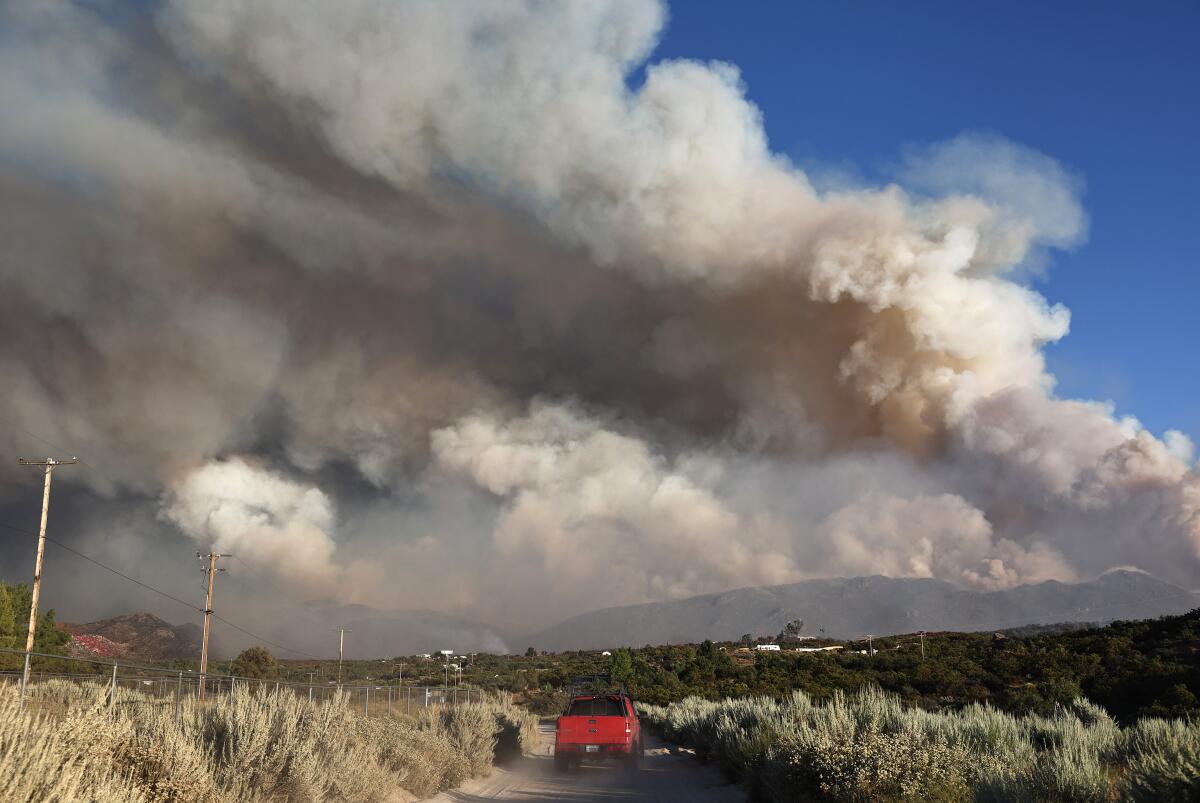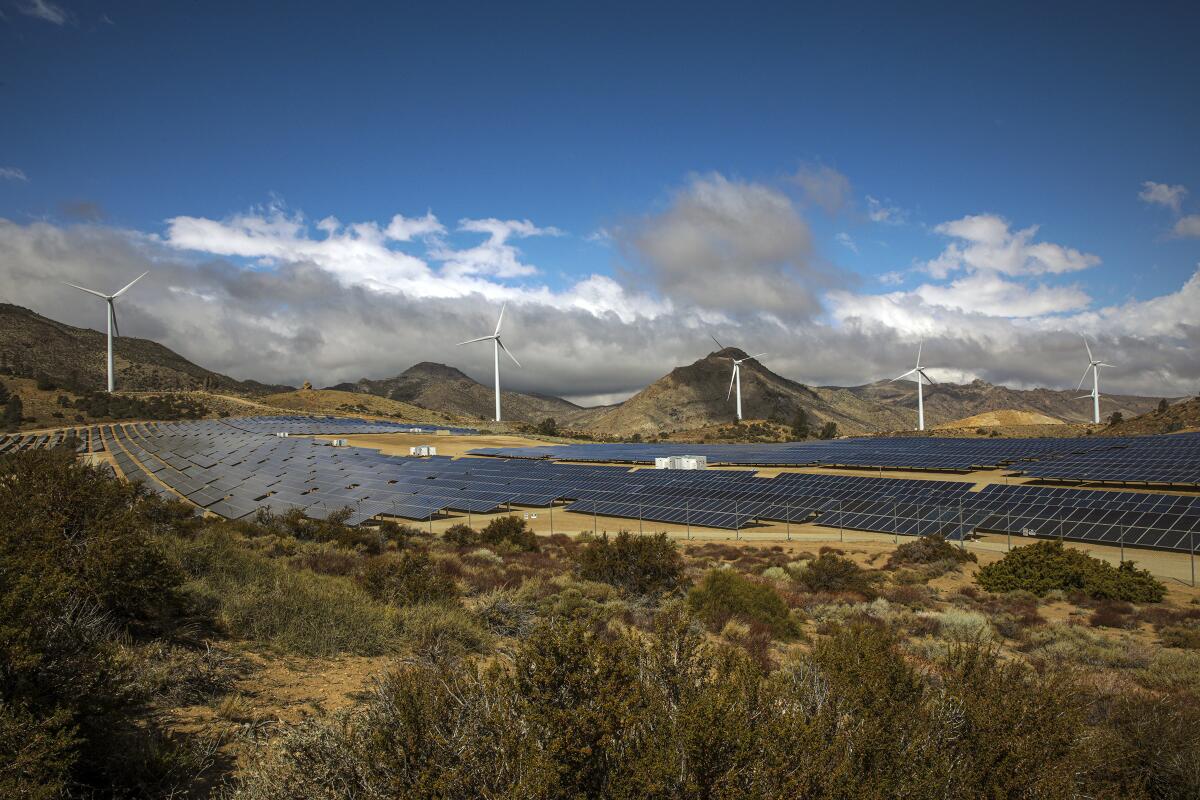Column: Don’t worry, it was only the second-hottest month ever

Great news: July 2024 was not the hottest July in recorded history.
Indeed, last month was a whole 0.04 degrees cooler than July 2023. It was, however, still Earth’s second-hottest month on record, and also the hottest month ever recorded for California. The Golden State’s average temperature was 81.7 degrees — surpassing the previous high mark by almost two degrees, as my L.A. Times colleague Grace Toohey reports.
You're reading Boiling Point
Sammy Roth gets you up to speed on climate change, energy and the environment. Sign up to get it in your inbox twice a week.
You may occasionally receive promotional content from the Los Angeles Times.
Numbers like those help explain why I don’t have much patience for people who claim, based on a poor understanding of climate science, that global warming is mostly a problem for the future, not the present. My impatience is buoyed by surveys such as this one, finding that 7 in 10 Americans say extreme heat has impacted their electricity bills in the last year. Something to keep in mind the next time you hear someone say that transitioning from planet-warming fossil fuels to clean energy is too expensive.
Something else to keep in mind? The risk of climate tipping points.
How close are we to irreversible catastrophes such as mass coral reef deaths, a Greenland ice collapse, a sudden shift in the West African monsoon or the loss of Amazon rainforest? The short answer, based on this story by the New York Times’ Raymond Zhong and Mira Rojanasakul, is we don’t know for sure. But we’re potentially close enough that we work furiously not to find out.
Even without a clearer picture of possible tipping points, there are worrisome patterns underway. My L.A. Times colleague Hayley Smith wrote about a new study identifying a seemingly vicious feedback loop in the Arctic, with melting permafrost fueling coastal erosion — probably resulting in less carbon absorbed by the ocean, and more heat-trapping gases in the atmosphere.
It all points to a need to ramp down fossil fuel combustion and other polluting activities as quickly as possible.
This knowledge has been circulating for a long time — many decades, in fact, even as fossil fuel companies tried to cover it up.
Grist’s Kate Yoder wrote last week about new research led by a Harvard University historian showing that climate change was on the minds of members of Congress in 1970 as they drafted the Clean Air Act. Even as far back as 1958, millions of kids were being alerted to the risks in their classrooms, through an animated movie produced by legendary filmmaker Frank Capra, Yoder writes.
This isn’t an easy problem to solve — some of the reasons for which I’ll mention below. But we have to try.
And now, here’s what else is happening around the West:
THE ENERGY TRANSITION

Trivia time: How many states have electricity that’s at least 50% climate-friendly?
Answer: 13!
Pretty good, right? Hydropower dams, nuclear reactors and wind turbines are the workhorses in most states, per this chart from Canary Media’s Carrie Klein and Dan McCarthy. But solar power is growing fast, with the potential to cover a lot of the distance to 100% clean energy. And lest you think clean energy is a threat to reliable power, California has kept the the lights on this summer even with the extreme heat. That hasn’t been the case in Texas with Hurricane Beryl, Politico’s Wes Venteicher writes.
For more hopeful news, look to Colorado. The state is doing some of the nation’s most innovative work on home electrification, Canary Media’s Klein reports, requiring a gas utility to help families switch to electric appliances. Look also to Albuquerque, where a new solar cell manufacturing factory is expected to create 900 jobs, per New Mexico Political Report’s Hannah Grover.
If only all the news were so hopeful.
My L.A. Times colleague Melody Petersen reports that data centers are gobbling up growing amounts of electricity and water in California — in part to power artificial intelligence — even as the state struggles to meet its clean energy goals and supply enough water. That’s a troubling trend, to say the least. The more renewable energy gets set aside for data centers, the less will be available to power the rest of the state — and the harder it will be to shut down fossil fueled generators.
And don’t trick yourself into thinking that building extra renewable energy is easy. As I’ve spent a decade documenting, almost anywhere you try to build a solar farm or wind turbine, someone will object — often for an excellent reason. In a recent example, a renewable energy developer paused permitting on a solar project in eastern Washington after the Confederated Tribes of the Colville Reservation raised concerns about harm to cultural sites, as B. ‘Toastie’ Oaster reports for High Country News.
Tribes and conservationists have concerns about damage from mining to supply electric car batteries and solar energy storage too. Writing for Inside Climate News, Wyatt Myskow has a fabulous piece on opposition to an Arizona copper and lithium mining boom that critics worry will drain and contaminate waterways as well as destroy sacred Indigenous sites. Also in Arizona, the Hualapai Nation is suing federal officials over their approval of lithium exploration, saying the drilling could threaten a sacred spring.
Even amid the challenges of clean energy, let’s not lose sight of the much worse harms wrought by fossil fuels.
Hotter heat waves, bigger wildfires, more intense storms and deadly air pollution are some of the big ones. But there are smaller ones too. A new study, for instance, has conclusively linked fracking wastewater injections with a blowout at a previously plugged oil well in the Permian Basin — “the first scientific proof of a phenomenon local landowners have long warned was occurring,” as Inside Climate News’ Dylan Baddour and the Texas Tribune’s Carlos Nogueras Ramos write.
On the other side of Texas, a federal appeals court just threw out permits for two natural gas export terminals on the state’s Gulf Coast. Details here from Canary Media’s Maria Gallucci. Closer to home, San Diego-based Sempra Energy — corporate parent of Southern California Gas and San Diego Gas & Electric — now says the gas export terminal it’s building in Baja California won’t be ready until spring 2026. That’s roughly six months behind schedule, the San Diego Union-Tribune’s Rob Nikolewski reports.
The next U.S. president and vice president won’t be able to stop climate change on their own. Far from it.
But I certainly read with interest, in this edition of Politico’s California Climate newsletter, that under the leadership of Gov. Tim Walz, Minnesota sued Big Oil over climate change before California did. (Counterpoint: Despite all the good press Walz has been getting on climate since Vice President Kamala Harris selected him as her running mate, Indigenous activists say he backtracked on a pledge to block the Line 3 tar sands crude oil pipeline. Details here from Heated’s Emily Atkin and Arielle Samuelson.)
Eighty-four days until the election.
AROUND THE WEST
Let’s start in California, since it’s indisputably the best place in the world (don’t @ me):
- I love this story about Southern California conservationists who take fallen urban trees and turn them into lumber for houses, desks and benches, so they don’t end up in landfills and contribute to the climate crisis. (Noah Haggerty, L.A. Times)
- Is a new bill in the state Legislature a commonsense measure to make sure houses are built to code in wildfire hazard zones? Or is it, as critics contend, a thinly veiled effort to unleash home building in fire hazard zones? (Hayley Smith, L.A. Times)
- California Insurance Commissioner Ricardo Lara is fast-tracking reviews of home insurance rate hikes. Some insurers have, in parts of the state, stopped writing policies as climate change fuels higher wildfire risk. (Laurence Darmiento, L.A. Times)
- The Biden administration issued an emergency order to halt the use of the popular weed killer Dacthal, saying it’s dangerous for farmworkers and fetuses. It’s commonly used on broccoli and onion fields. (Salvador Hernandez, L.A. Times)
Before leaving the Golden State, let’s take a journey along the coast:
- Climate change is probably playing a role in an ocean neurotoxin outbreak that’s killing sea lions. (Susanne Rust, L.A. Times)
- The U.S. military is rejecting calls from the California Coastal Commission to address environmental consequences from a growing number of SpaceX rocket launches and sonic booms in Santa Barbara County. (Salvador Hernandez, L.A. Times)
- Check out this eye-opening investigation into the threat posed by rising seas to Bay Area schools. (Ezra David Romero, KQED)
Expanding our lens a little bit, let’s venture to some of California’s neighbors:
- In Arizona, the Colorado River Indian Tribes have some of the largest, highest-priority water rights in the Southwest. And now they can lease out their Colorado River water. What kinds of deals might the tribes pursue? (Brett Walton, Circle of Blue)
- Nevada’s Republican governor, Joe Lombardo, released a new statewide climate plan, a year and a half after throwing out his Democratic predecessor’s previous version. It’s 33 pages long and short on specifics. (Amy Alonzo, the Nevada Independent)
Before wrapping up, how about we spend some time outside:
- Here’s a terrifying story about the century-old cables that don’t stop some climbers from dying as they ascend Half Dome at Yosemite. There’s controversy afoot — read the story for details — but I’d say just upgrade the cables. (Jack Dolan, L.A. Times)
- There will be more protected acreage for Mojave desert tortoises and other wildlife between the Coachella Valley and Joshua Tree National Park, thanks to a $4-million purchase by Oswit Land Trust in the Indio Hills. (Janet Wilson, the Desert Sun)
- Check out this great advice on what to do next time you encounter a rattlesnake on the trail. (Jaclyn Cosgrove, L.A. Times)
Last but not least: My L.A. Times colleague Neenma Ebeledike has advice on how to protect your pets from extreme heat.
ONE MORE THING

The Olympics are supposed to bring out the best in humanity. Maybe in Los Angeles, they will.
Mayor Karen Bass said the 2028 event can be a “a no-car Games.” That won’t be the case, but there’s lots of public transit being planned, as my L.A. Times colleague David Wharton reports. I’m also salivating at the thought of a Metro train line running from LAX to the Hollywood Bowl, although it won’t be ready until an estimated 2049, per this story by Jasmine Mendez. Sigh.
Also disappointing: This ad run by the Western States Petroleum Assn., an oil industry lobbying group based in Sacramento, that ran on TV during Olympics broadcasts. The ad suggests that California policies are to blame for high electricity, gasoline and food prices, and directs viewers to a website that spews more propaganda — while totally ignoring the costs of climate change.
I wish NBC wouldn’t accept ads like that, for the same reason I wish the Dodgers wouldn’t accept oil industry sponsors.
It’s not just the Dodgers; this a problem across sports. Three Major League Baseball teams — the Houston Astros, Texas Rangers and Cleveland Guardians — wear jersey patches sponsored by oil and gas firms. Their players are walking ads for fossil fuels.
The Guardians’ jersey patch sponsor, by the way, is Marathon Petroleum, whose Arco subsidiary is this year’s lead sponsor for a series of Dodgers Foundation events that offers health screenings and education programs for youth baseball players and their families. As I’ve written previously, it’s a great way to lull people into forgetting that oil and gas are terrible for our health.
A growing coalition of climate advocates is calling on Dodgers owner Mark Walter to end the team’s relationship with its most prominent fossil fuel advertiser, Phillips 66 (owner of gas station chain 76). As fantastical as that may sound to some fans, there’s a long history of baseball teams refusing to accept unsavory ad dollars. As the L.A. Times reported in 1993, the Dodgers refused to permit tobacco ads at Chavez Ravine from the day the stadium opened in 1962 — decades ahead of many of their peers.
This is the latest edition of Boiling Point, a newsletter about climate change and the environment in the American West. Sign up here to get in your inbox. Or open the newsletter in your web browser here.
For more climate and environment news, follow @Sammy_Roth on X.
Correction: Thursday’s newsletter stated that U.S. Rep. Katie Porter (D-Irvine) had signed the letter urging Dodgers owner Mark Walter to end the team’s sponsorship deal with Phillips 66. Porter’s office said she did not sign the letter. My apologies.
Toward a more sustainable California
Get Boiling Point, our newsletter exploring climate change, energy and the environment, and become part of the conversation — and the solution.
You may occasionally receive promotional content from the Los Angeles Times.




